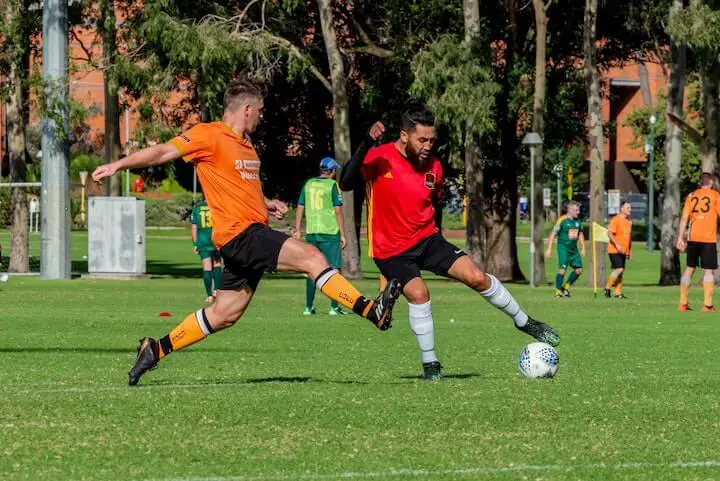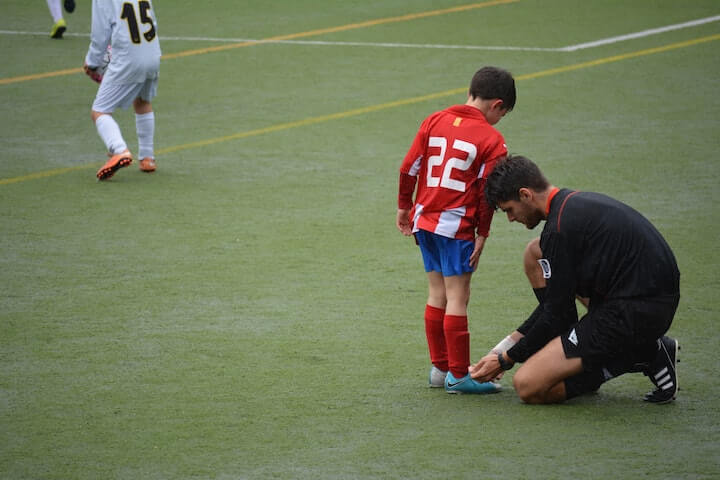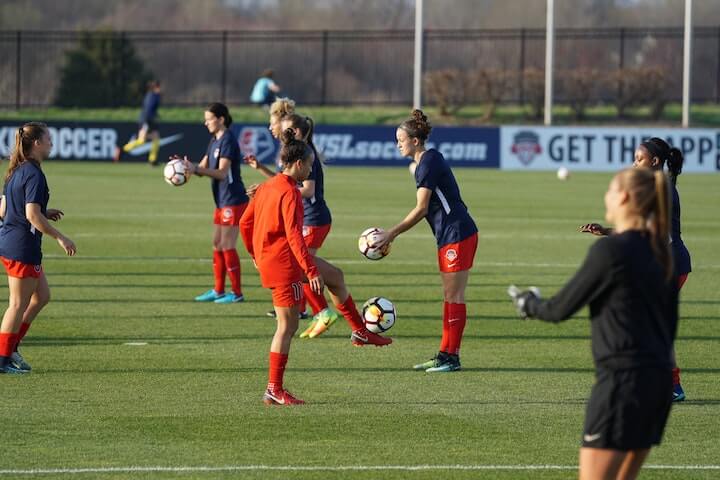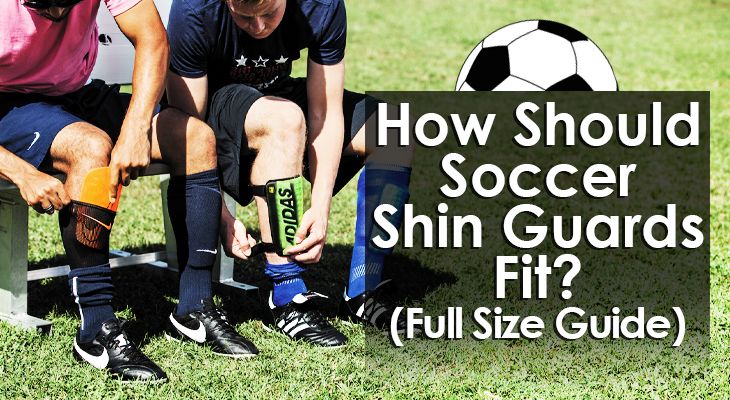How Should Soccer Shin Guards Fit? (Shin Guard Size Chart)
Shin guards are one of five mandatory pieces of equipment that all players must wear.
According to the IFAB, the organization that governs the official Laws of the Game...
"On-field competitors must have shin guards made from suitable materials to offer appropriate levels of protection for the lower legs."
Naturally, it’s important to find shin guards that fit right and offer adequate protection.
But shin guards aren’t uniform in size...
Depending on your height, the shape of your leg, the condition of your joints, and several other factors, you may require a certain style or size of shin guard.
If you’re wondering, how should soccer shin guards fit, this article breaks down the different designs and offers advice on how to find the right shin guards for your body type.
Shin Guard Size Chart
Most major sports brands manufacture shin guards for all ages in various sizes and styles.
Gear manufacturers typically recommend shin guard sizes based on height as this often gives the best gauge of the coverage needed to protect your shins.
While this gives you a good idea of the size you need, it isn’t a flawless approach, since body types involve a lot more than height alone.
Size recommendations can depend on the manufacturer so be sure to read the packaging or size guide before making a purchase.
You can use the following chart as a general size guide for shin guards.
Player Height | Shin Guard Size |
|---|---|
4'7" - 4'11" | Extra Small (XS) |
4'11" - 5'3" | Small (S) |
5'3" - 5'7" | Medium (M) |
5'7" - 5'11" | Large (L) |
5'11" - 6'3" | Extra Large (XL) |
6'3" + | Extra-Extra-Large (XXL) |
Types of Shin Guards
One of the most important factors in finding the right size shin guards is identifying "style".
The three main types worth considering are:

#1 - Slip-In Shin Guards
Slip-in shin pads are the most popular type in the modern game, worn by the vast majority of professional players.
They're extremely lightweight but still offer solid shin protection through the hard plastic or carbon fibre front plate.
As the name suggest, these pads simply slip under your socks and rest on the shin.
Many players opt to use compression socks, sleeves, or tape to hold them in place throughout training or a game, though some come with straps that fasten around your legs for a tight fit.
The main advantage of slip-in shin guards is mobility.
They allow excellent freedom of movement and are probably the most comfortable and unrestrictive options available.
The downside is that they don’t always offer maximum protection.
These guards don’t come with ankle support and are generally designed with mobility in mind, rather than total leg protection.
Popular Among the Pros
At a professional level, aggressive tackling has been significantly reduced in recent decades.
Moreover, players no longer wear large studs or razor sharp blades on the bottom of their cleats.
Soccer fields are more akin to carpets than grass you’d find in your local park, allowing players to glide over the turf.
These factors mean that professionals are less concerned about protection and more conscious of optimizing their performance and mobility.
So, if you play at a high level and aren’t concerned about being on the receiving end of a rash tackle, slip-ins are a great option.
However, if your rec league is quite physical and features lackadaisical officiating, perhaps a more robust type of shin guard would be of better use.
#2 - Ankle Protection Shin Guards
If you’re worried about rolling your ankle on a muddy field or getting kicked around by opposing players, shin guards with built-in ankle protection are often worth the investment.
These shin guards are usually designed similarly to slip-in pads but the have a stirrup-style ankle attachment with padding around the ankle for extra support and protection.
Some brands have shin guards with detachable ankle supports, allowing you to use the extra protection as you need it.
Ankle protection shin guards are an excellent option for developing players, rec league competitions, or as a back up pair if you’re carrying a knock.
#3 - Shin Guard Sleeves
Shin guard sleeves are a relatively new style that are essentially socks with built-in padding.
Most sleeves come without ankle protection.
However, what they lack in padding, they make up for in comfort.
The key to getting the right fit for shin guard sleeves is finding a snug compression level.
This ensures they stay in place as you move and ride tackles.
Pay particular attention to the manufacturers’ size guides and try them on in-store if possible.
Due to the comfort and simple design, sleeves are a great lightweight option for training or youth level soccer.

How Should Soccer Shin Guards Fit?
If you’re new to the sport or are looking for a way to add a little extra protection to your lower body, it’s important to find the right size shin guards.
Here are some tips to help you get the perfect fit:
a. Length of Shin Guards
The ideal shin guard length depends on the length of your leg.
The top of the guard should be approximately two inches from your knee, while the bottom should sit between one and two inches above your ankle.
This provides ample protection while allowing enough space for optimal mobility.
b. Width of Shin Guards
You may have to shop around and try out different brands to find a shape that fits comfortably.
Some models are hard plastic and keep a rigid shape that may not sit well.
Others are more flexible and conform to your leg after a few wears.
Whatever style you choose...
Make sure it doesn’t leave any part of the front of your leg exposed.
c. Snug Fit
As a rule of thumb, your shin guards should conform to the shape of your shin and have a relatively snug fit with minimal gaps.
This ensures the pads do their job and absorb the force of a tackle.
For a tight, protective fit, choose a pair with plenty of foam cushioning behind the front plate.
Over time, the foam will adapt to the shape of your leg.

Shin Guard Sizing Tips
Unless you get custom shin guards made from molds of your legs, there’s a good chance you’ll need to to find some compromises to get the right fit.
Here are some pro tips for ensuring a snug fit while staying protected:
Tip #1: Find a Balance Between Comfort and Protection
While you don’t want your gear to be overly bulky, there is a fine line between functional and pointless when it comes to shin guards.
Opt for a pair that offer protection without restricting your movement.
Tip #2: Use Additional Tape if Necessary
If you’re in-between sizes, use tape or extra straps to help secure your shin guards.
Even professionals tape up their gear before a game.
Tip #3: Wear Sleeves for a Tighter Fit
Some players prefer sleevers over tape as it applies more even pressure around your leg, creating a tighter but more comfortable fit.
Tip #4: Consider Your Position
If you’re a defender or combative midfielder who enjoys a good tackle...
...you might need extra protection.
While speedy wingers often choose lightweight slip-in shin pads to suit their playing style.
Conclusion
Shin guards are one of the most important pieces of soccer equipment a player will own.
Feeling comfortable on the field is essential for optimal performance.
If you were wondering how soccer shin guards should fit, now you know.
You should also be wary of your safety, especially when it comes to your feet and legs.
Bad injuries can reoccur throughout your career so minimizing risk should be a priority.
Remember that the positioning, leg coverage, and a snug fit are the key factors when finding the right size shin guards.

